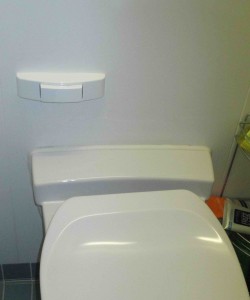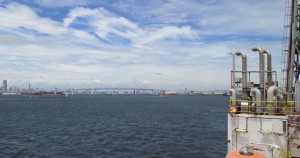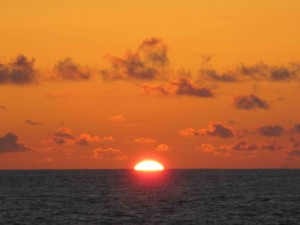Entry Two: It’s all about timing
Over the past few days, my thoughts have been consumed with the perception of time.
But first things first. Many must be waiting with baited breath after my last informative portrayal of Japanese toilets…. so I have included a picture of their counterparts on the JR. A single button. No room for ambiguity. One every day life challenge is averted. 
We boarded the JR on the 31st of July and departed Yokohama on the 4th of August. (see obligatory Yokohama bridge photo). Our JR-based port call seemed somewhat unending. When we were finally ready to depart many (including myself) felt as though we had been together for months! Do not misunderstand – this is not a negative feeling, just a surreal one. 
The scientists and technical staff have got to know each other better during our 7 month (read: 4 day) JR-based port call in Yokohama. The first few days consisted of meetings, then a few more meetings, then some training, then meetings, and after that, just for a change, a few more meetings. In all seriousness, there is a vast amount of information to assimilate before we get onsite. Having been on this ride once before, I am feeling fairly confident about what I need to do, however memories of the heady mix of confusion/excitement of the first time round surface from time to time.
Walking the corridors of the JR, I feel as if I was here only months ago, not the 5 years it has actually been since my last IODP expedition. We are only mere days into Expedition 352 and already my ‘regular’ life seems a bit fuzzy, out-of-focus – as if it belongs to someone else. Again, not a negative thing. In fact, total immersion is one of the aspects of sailing IODP that I find very attractive. It is a rare environment that brings together scientists from disparate disciplines and unites them in a single set of aims. The combination of shared goals and removal of distractions creates the most exciting scientific environment I have ever encountered.
We are entering the work-horse phase. The meat of the sandwich. Up to this point, we have all been sleeping at (more or less) the same times. Yesterday/today/tonight (what day is it again?) is when we begin to ‘get on shift’. All scientists work 12 hour shifts every single day of our 55 days at sea. The ‘day’ shift runs 12pm-12am and the ‘night’ shift runs 12am-12pm. Certainly more appropriate terms would be ‘sunrise’ and ‘sunset’ shifts, but who I am to fly in the face of tradition. I am part of the sunrise shift (it’s my blog, I’ll call it what I want). My task – as I write this – is to stay awake for the next 12 hours. I was fortunate enough to be very ‘tired’ after our last night festivities in Yokohama and was, miraculously, able to sleep a straight 7 hours from 1pm-8pm yesterday (today??). I include photographic evidence of some measure of my success: the first sunrise of Expedition 352 taken around 4:50am. 
What else is on our minds? Typhoons. Check out the JR website and our educator, Beth Christiansen’s blog for more information about some potentially troublesome beasts (joidesresolution.org). Our estimated time to our first drill site is about 28 hours at the time of writing. Core some 10-12 hours after that.
Finally, please do ask any questions you like in the comments section. I welcome all types and will certainly find the ‘time’ to answer them!
August 5th 2014